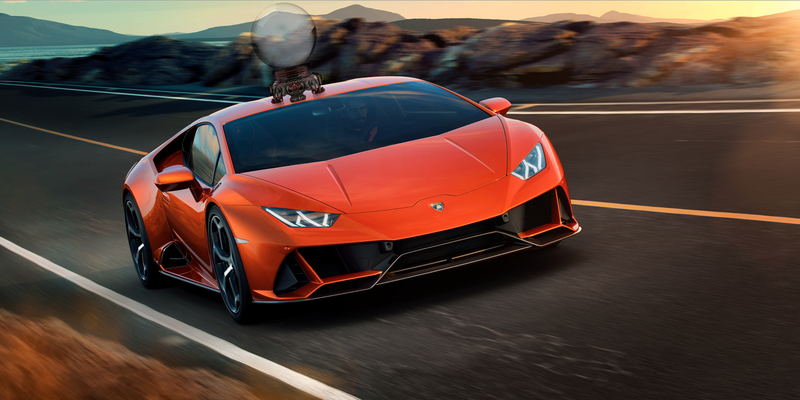
This press release from Lamborghini about the new Huracán EVO might have the most sci-fi sounding mass of techno-jargon that I’ve seen in a long time. It’s got sentences like “The magneto rheological suspension, upgraded to version 2.0, instantaneously adapts the damping following inputs from the LPI,” and “A ‘feed forward logic’ is implemented via the dynamic controller, which means the car doesn’t just react, but predicts the best driving set-up for the next moment.”I wonder if it can also reverse the polarity in its EPS conduits, if needed.
On a more immediately understandable level, the Huracán EVO does get a power and torque boost, up to 640 horsepower and 443 lb-ft respectively, thanks to new titanium intake valves and a “refined lightweight exhaust system.”
The EVO weighs 3,134 pounds, which gives it a power-to-weight ratio of 4.9 pounds per horsepower, which means it can go from still to 62 mph in a eye-and-pants-watering 2.9 seconds. It’s plenty fast.
While that’s fun, what Lamborghini really seems to want to let us know is that the new EVO is also somehow smart. Well, maybe not just smart, but creepily AI-smart, in that they’re suggesting that its Lamborghini Dinamica Veicolo Integrata (LDVI)—the main computer system that runs the show, dynamically, at least, has some ability to predict the future, at least in the context of what is likely to come next, driving input-wise:
The Huracán EVO features new Lamborghini rear-wheel steering and a torque vectoring system working on the four wheels, while at the heart of the car is the new feature of Lamborghini Dinamica Veicolo Integrata (LDVI): a Central Processing Unit that controls every aspect of the car’s dynamic behaviour, fully integrating all of the car’s dynamic systems and set-up to anticipate the next move and needs of the driver, interpreting this into perfect driving dynamics.
Lamborghini Piattaforma Inerziale (LPI), a comprehensive set of accelerators and gyroscope sensors placed at the car’s center of gravity, has been enhanced to version 2.0. With improved precision, it monitors in real-time the dynamic vehicle attitude regarding lateral, longitudinal and vertical accelerations, as well as roll, pitch and yaw rate. The magneto rheological suspension, upgraded to version 2.0, instantaneously adapts the damping following inputs from the LPI. A new advanced traction control system together with enhanced all-wheel drive and torque vectoring, allows traction to be directed to a single wheel as required.
Advertisement
The actions that can be taken by the EVO to prepare itself for its immediate and speedy future also now include rear-wheel steering and torque vectoring on all the wheels.
The look of the Huracán has been tweaked a bit, too, mostly to accomodate new aerodynamic developments. There’s a new front bumper, with an integrated splitter and wing, air intakes have been enlarged, there’s a new wheel design, new side air intake design, and around back the exhausts are higher (closer to nose level for optimal olfactory enjoyment), and there’s a new integrated spoiler.
Advertisement
If you’re a squirrel, you may notice a new set of underbody aero panels as well. All of these changes together make the EVO have better downforce than past Huracáns, and it’s now five times more aerodynamically efficient than the first-gen Huracán.
If you’re looking to buy a car that is capable of at least a very limited sort of Nostradamus-izing, then you’ll need $261,274 to pick one of these up when they’re available this spring.
If theres’s some way you can translate stock market trends into wheel slip, velocity, steering input, and lateral G loads, you could make a hell of a lot of money. Good luck!















